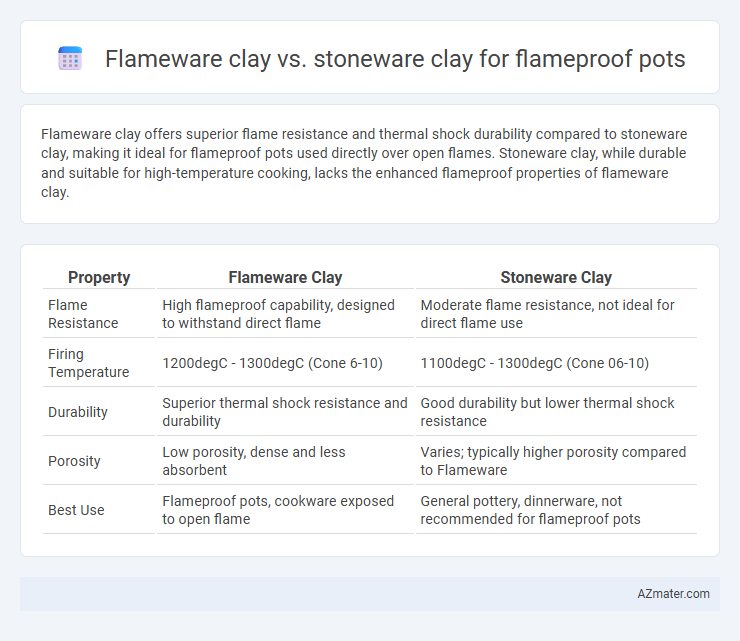Flameware clay offers superior flame resistance and thermal shock durability compared to stoneware clay, making it ideal for flameproof pots used directly over open flames. Stoneware clay, while durable and suitable for high-temperature cooking, lacks the enhanced flameproof properties of flameware clay.
Table of Comparison
| Property | Flameware Clay | Stoneware Clay |
|---|---|---|
| Flame Resistance | High flameproof capability, designed to withstand direct flame | Moderate flame resistance, not ideal for direct flame use |
| Firing Temperature | 1200degC - 1300degC (Cone 6-10) | 1100degC - 1300degC (Cone 06-10) |
| Durability | Superior thermal shock resistance and durability | Good durability but lower thermal shock resistance |
| Porosity | Low porosity, dense and less absorbent | Varies; typically higher porosity compared to Flameware |
| Best Use | Flameproof pots, cookware exposed to open flame | General pottery, dinnerware, not recommended for flameproof pots |
Introduction to Flameware and Stoneware Clays
Flameware clay is specifically formulated to withstand direct flame exposure without cracking, making it ideal for flameproof pots used on stovetops or open flames. Stoneware clay, known for its durability and heat retention, is fired at high temperatures to create a dense, non-porous surface but is not always suitable for direct flame contact. Understanding the thermal properties and firing requirements of flameware versus stoneware clays is crucial when crafting pots that require flame resistance and longevity.
Defining Flameware Clay: Properties and Composition
Flameware clay is a specialized type of ceramic material engineered to withstand direct exposure to open flames and rapid temperature changes, making it ideal for flameproof pots. Its composition typically includes a high percentage of refractory materials such as alumina and silica, which enhance thermal shock resistance and durability under extreme heat. Unlike stoneware clay, which is fired at high temperatures to achieve strength and hardness, flameware clay is formulated specifically to endure continuous flame contact without cracking or degrading.
Understanding Stoneware Clay: Features and Composition
Stoneware clay, composed primarily of kaolinite, feldspar, and quartz, is known for its durability and high firing temperature between 1200degC and 1300degC, which creates a dense, vitrified body ideal for flameproof cookware. Its inherent strength and low porosity make stoneware resistant to thermal shock and suitable for direct flame exposure. Compared to Flameware clay, stoneware offers superior structural integrity and long-lasting performance in high-heat cooking applications.
Heat Resistance: Flameware vs. Stoneware
Flameware clay offers superior heat resistance compared to traditional stoneware clay, sustaining direct flame exposure up to approximately 2400degF (1315degC) without cracking or warping. Stoneware clay typically withstands temperatures between 2150degF and 2300degF (1177degC to 1260degC) but is less suitable for direct flame use, making it more prone to damage under open flame conditions. These thermal properties position Flameware as the preferred choice for flameproof pots requiring consistent durability and heat tolerance in high-temperature cooking environments.
Thermal Shock Tolerance in Pot Making
Flameware clay exhibits superior thermal shock tolerance compared to stoneware clay, making it ideal for flameproof pot construction where rapid temperature changes are frequent. Its composition includes specific refractory materials that withstand sudden heat exposure without cracking, unlike traditional stoneware which may fracture under extreme thermal stress. This enhanced durability ensures longer lifespan and safety for flameware pots used over direct flames or high-heat surfaces.
Durability and Longevity of Flameproof Pots
Flameware clay is specifically formulated to withstand rapid temperature changes, making flameproof pots highly resistant to thermal shock and less prone to cracking during direct flame exposure. Stoneware clay, known for its dense vitrification after firing, offers exceptional durability and chip resistance, ensuring the flameproof pots maintain structural integrity over long-term use. When comparing these materials, flameware provides superior thermal durability, while stoneware excels in physical robustness, both contributing significantly to the longevity of flameproof cookware.
Safety Concerns: Cooking Over Direct Flame
Flameware clay is specifically formulated to withstand direct, high-temperature exposure without cracking, making it ideal for flameproof pots used over open flames. Stoneware clay, while durable and heat-resistant, may not tolerate the intense thermal shock from direct flame cooking as effectively, increasing the risk of breakage or food contamination. Prioritizing flameware clay ensures enhanced safety by minimizing hazards related to material failure during cooking on stovetops or campfires.
Ease of Use and Maintenance Comparison
Flameware clay is engineered for direct flame exposure, offering superior thermal shock resistance compared to stoneware clay, which requires cautious heating to avoid cracking. Stoneware clay is generally easier to work with due to its plasticity and lower firing temperature but demands careful seasoning and cleaning to maintain flameproof qualities. Maintenance of flameware clay pots is simpler as they resist staining and thermal stress, whereas stoneware requires more frequent inspection for micro-cracks and gradual wear.
Suitability for Different Cooking Methods
Flameware clay offers superior thermal shock resistance, making it ideal for direct flame cooking, such as open flame stoves and campfires, where rapid temperature changes occur. Stoneware clay, while robust and durable, excels in even heat distribution and is better suited for oven baking and slow cooking methods due to its dense structure. Choosing between Flameware and Stoneware clay depends on the primary cooking method: Flameware is optimized for direct flame exposure, whereas Stoneware is optimal for indirect heat and steady, prolonged cooking.
Choosing the Best Clay for Flameproof Pots
Flameware clay, formulated with high alumina content, offers superior heat resistance and thermal shock durability compared to standard Stoneware clay, making it ideal for flameproof pots exposed to direct flame or rapid temperature changes. Stoneware clay, while robust and durable, may crack under intense heat due to lower thermal shock resistance, limiting its suitability for flameproof applications. Selecting Flameware clay ensures enhanced safety and longevity for flameproof pots used on stovetops or open flames.

Infographic: Flameware clay vs Stoneware clay for Flameproof pot
 azmater.com
azmater.com